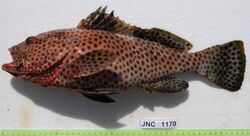Biology:Pseudorhabdosynochus cuitoe
| Pseudorhabdosynochus cuitoe | |
|---|---|
| Scientific classification | |
| Domain: | Eukaryota |
| Kingdom: | Animalia |
| Phylum: | Platyhelminthes |
| Class: | Monogenea |
| Order: | Dactylogyridea |
| Family: | Diplectanidae |
| Genus: | Pseudorhabdosynochus |
| Species: | P. cuitoe
|
| Binomial name | |
| Pseudorhabdosynochus cuitoe Justine, 2007
| |
Pseudorhabdosynochus cuitoe is a diplectanid monogenean parasitic on the gills of the Highfin grouper, Epinephelus maculatus. It has been described in 2007.[1]
Description
Pseudorhabdosynochus cuitoe is a small monogenean, 0.3-0.5 mm in length.[1] The species has the general characteristics of other species of Pseudorhabdosynochus, with a flat body and a posterior haptor, which is the organ by which the monogenean attaches itself to the gill of is host. The haptor bears two squamodiscs, one ventral and one dorsal. The sclerotized male copulatory organ, or "quadriloculate organ", has the shape of a bean with four internal chambers, as in other species of Pseudorhabdosynochus.[2] The vagina includes a sclerotized part, which is a complex structure.
Etymology
Pseudorhabdosynochus cuitoe is part of a series of eight species of Pseudorhabdosynochus with similar names. All these species are parasitic on the Highfin grouper, Epinephelus maculatus. According to the author,[1] names of the new species have been formed on the base of "uitoe", the local name of the host, the Highfin grouper, and letters a–h, in accordance to International Code of Zoological Nomenclature articles 57.6 (one-letter difference) and 32.5.2.4.4 (no punctuation). The eight species sharing this etymology are P. auitoe, P. buitoe, P. cuitoe, P. duitoe, P. euitoe, P. fuitoe, P. guitoe, and P. huitoe.
Hosts and localities
The type-host and only recorded host of P. cuitoe is the Highfin grouper, Epinephelus maculatus (Serranidae: Epinephelinae). The type-locality and only recorded locality is the Barrier Reef off Nouméa, New Caledonia.[1]
References
- ↑ 1.0 1.1 1.2 1.3 Justine, Jean-Lou (2007). "Parasite biodiversity in a coral reef fish: twelve species of monogeneans on the gills of the grouper Epinephelus maculatus (Perciformes: Serranidae) off New Caledonia, with a description of eight new species of Pseudorhabdosynochus (Monogenea: Diplectanidae)". Systematic Parasitology 66 (2): 81–129. doi:10.1007/s11230-006-9057-3. PMID 16972153.
- ↑ Kritsky, D. C. & Beverley-Burton, M. 1986: The status of Pseudorhabdosynochus Yamaguti, 1958, and Cycloplectanum Oliver, 1968 (Monogenea: Diplectanidae). Proceedings of the Biological Society of Washington, 99, 17-20. PDF

Wikidata ☰ Q1866813 entry
 |


